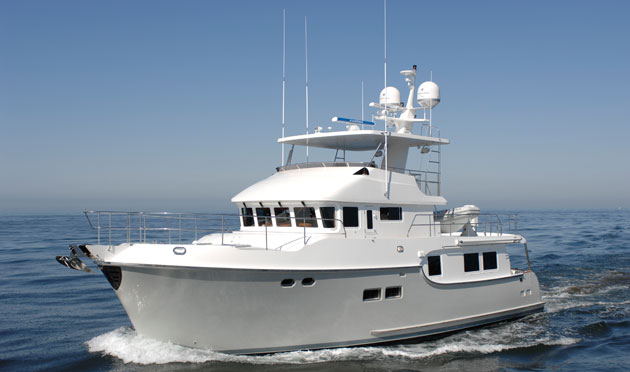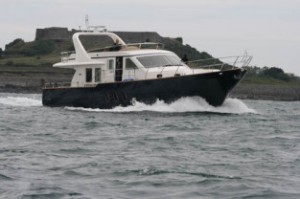Our technical expert Dave Marsh explains how induced drag can affect the fuel efficiency of your boat
Meandering around the MBY.com forum recently, I stumbled across a thread that threw up some interesting questions about the nature of drag; the resistance that a boat encounters as it moves through the water.
In among the discussions was a mention of Greek mathematician and all round genius Archimedes, doubtless because his famous principle – that a body immersed in a fluid experiences a buoyant force equal to the weight of the fluid it displaces – chimes with those of us who don’t like that sinking feeling.
Anyway, drag is a complex issue, and while Archimedes does indeed keep us afloat while we’re lounging around in the marina, the issue of how drag is generated and what happens once we get moving wasn’t really the famous polymath’s concern.
So what exactly does hold back our different boats under way? A few oddities aside, almost every motor boat experiences six forms of drag: the well known pair of wave making and frictional resistance, the overlooked aerodynamic aspect, plus three of the less well known impediments comprising form drag, induced drag, and spray-making drag.
At low speed, almost all conventional hull forms initially generate a pair of wave trains, at the bow and the stern respectively.
These take energy to produce, and some of the energy generated by your boat’s movement manifests itself as wave-making resistance.
Everything experiences frictional resistance too (aerodynamic as well as hydrodynamic) but at low speed this is often quite modest.
That’s because frictional resistance is (roughly) proportional to the square of a boat’s speed. So all other things being equal, a jump from 10 knots to 30 could mean a nine-fold increase in this form of drag.
A variety of drag
All hull forms; displacement, planing, and semi-displacement, also exhibit form drag. This is the trickiest to unravel because it’s intertwined with most of the other types of drag.
However, in simple terms it can be thought of as the reluctance of a shape to being dragged through the water.
 So a bulbous Nordhavn (like the one pictured above) would have high form drag, whereas a slender catamaran would be at the opposite end of the scale.
So a bulbous Nordhavn (like the one pictured above) would have high form drag, whereas a slender catamaran would be at the opposite end of the scale.
Although a shape with high form drag will invariably tend to push up bigger waves, although they are interconnected they are not the same thing – submerged objects have form drag too.
It’s far from insignificant, as evidenced by the greatly reduced drag of a streamlined sterndrive leg against a conventional shaftdrive sterngear.
The combination of modest installed power, hull shape and great mass means that full displacement boats cannot overcome their considerable wave-making drag, so they’re typically limited to a smidgen over the maximum theoretical hull speed of 1.34 x √LWL (where √LWL is the square root of the waterline length in feet).
In real world terms that would be, say, around 10 knots on a Linssen Grand Sturdy 52.9 with its 44ft LWL. So that’s where we have to leave our Linssen, stuck at 10 knots with a degree of form drag, modest aerodynamic and hydrodynamic frictional resistance, and the majority of its drag as wave making.
Taking the middle ground
Meanwhile, our semi-displacement boat is powering ahead. Its lighter weight, increased power, and more slender form allow it to easily exceed the 1.34 x √LWL threshold.
Eventually though, this type of boat will normally start to run out of puff as it approaches speed–length ratios around 4.0, i.e. 4.0 x √LWL – say 28 knots for an AquaStar 57 (pictured below) with a waterline length of 49ft.
 Like a planing boat, it will be generating dynamic lift, but its more rounded form can rarely generate sufficient lift to allow it to break free from its wave trains and their associated drag.
Like a planing boat, it will be generating dynamic lift, but its more rounded form can rarely generate sufficient lift to allow it to break free from its wave trains and their associated drag.
Also, at these speeds the archetypal long deep keel will be adding appreciably to speed-sapping frictional resistance.
Even the most slippery of semi-displacement hulls are ultimately hampered by the way frictional resistance changes with increasing speed.
At low speed, the water molecules in closest contact with the hull are slowed due to friction, but the flow within that thin boundary layer is smooth and undisturbed.
As speed increases, that smooth flow thickens and eventually becomes disturbed and breaks down into more turbulent flow.
That results in increased viscous drag, not so much between the water and hull surface itself, but within the turbulent flow that has become separated from the hull.
Laminar flow is one of the principal reasons that dolphins, for instance, can swim so fast relative to their ‘installed horsepower’.
Their ultra streamlined shape allows the water to flow around them smoothly and close up behind them, so they maintain laminar flow very effectively, although not always of course.










